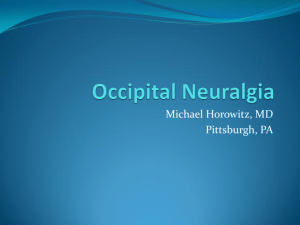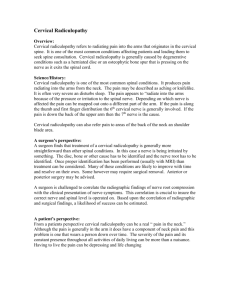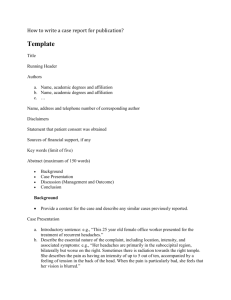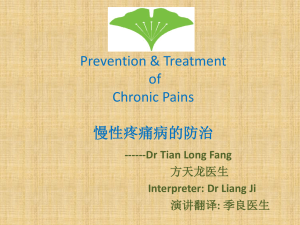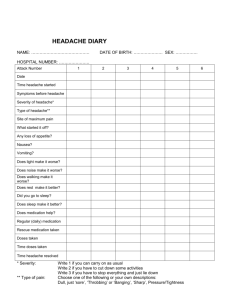Geriatrics
advertisement
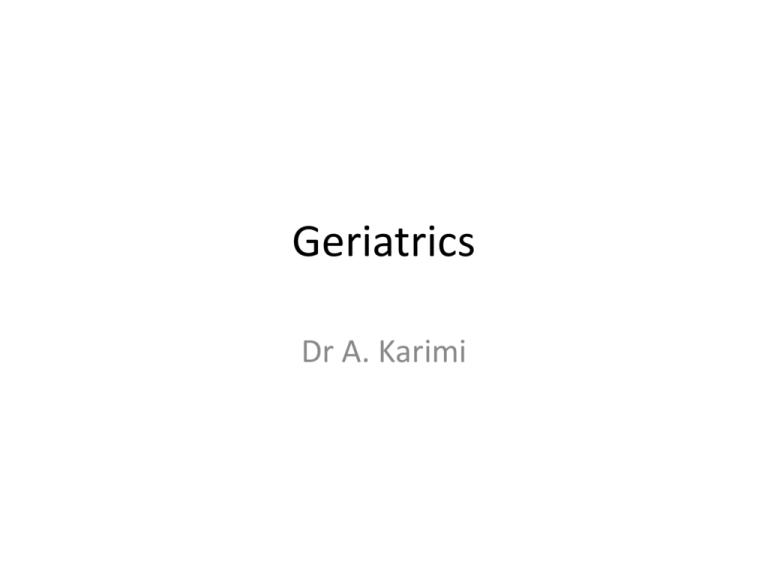
Geriatrics Dr A. Karimi Process of EBP • Many of the interventions we use today, have still to demonstrate much more in the way of effectiveness. • They may soon change with the recent emphasis within many health care professions on evidence based clinical practice. Process of EBP • 1. identify the patient problem. Derive a specific question • 2. Search the literature • 3. Appraise the literature • 4. Integrate the appraisal of literature with your clinical expertise, experience, patient values, and unique circumstances • 5.Implement the findings • 6. Assess outcome and reappraise • systematic review Clinical Guidelines 3 Role of musculoskeletal system in health and disease • A coat rack on which the other organs are held? • Broader context: integral and interrelated part of the total human organism. 5 basic concepts: • • • • • Holism Neurologic control Circulatory function Energy expenditure Self regulation Holism • Musculoskeletal system should be evaluated in every patient. • Our role is to treat patient not to treat disease. Neural control 1 • 1) Somato-somato reflex pathway • 2) Viscero-visceral reflex arc (pilomotor activity of the skin, vasomotor tone, secretomotor activity of the sweat glands) • 1 and 2 are interrelated: somatic afferents influence visceral efferents and visceral affferents influence somatic efferents. • + • • • Ascending and descending pathways from other spinal segments + And from higher centers of the brain Neural control 2 • Autonomic nervous system (ANS) • Parasympathic: some cranial nerves (III, VII, VIII, IX, X and s2, s3, s4). • The largest parasympathic nerve is Vagues which innervate all of the viscera and glands and smooth muscles of these organs. • Sympathetic: preganglionic neurons originating from T1-L3 and collateral ganglia. • Sympathetic fibers innervate all of the visceral (segmentally): visceral above diaphragm from preganglionic fibers above T4 and T5, viscera below diaphragm from preganglionic fibers below T5 : Neural control 2 • Through this segmental organisation is the correlation of certain parts of musculoskeletal system and certain internal viscera. • Musculoskeletal system only receive sympathetic division. • Nervous system are intimately related to endocrine system: neuroendocrine control. • By knowledge on neurotransmitters, endorphins, enkephaline, … we now understand why biomechanical alteration of musculoskeletal system can alter bodily function. Neural control 2 • Nervous system is a powerful trophic function as well, complex protein and lipid substances are transported antegrade and retrograde along neurons and across synaps of the neuron to the target end organ. • Alteration in the neurotrophin transmission can be detrimental to the target end organ. Circulatory function • The cell is dependent for its function to delivery of oxygen and glucose, and other substances being supplied by the artery. • The arterial system has a powerful pump: • Myocardium of the heart, this pumping is controlled by CNS particularly ANS. • Vascular tree receives its vasomotor tone control by sympathetic division of ANS. • Anything that interferes with sympathetic , segmentally , can influence vasomotor to a target end organ. • Arteries are also encased in facial compartments of the body, and are subject to compressive and tensional stress that can interferes with its delivery. Circulatory function • • End products must be removed. Venus and lymphatic system are responsible, not a cardiac pump, instead depending to musculoskeletal system and large muscles of the extremities. • The major pump however is diaphragm. Its attachment to musculoskeletal system, negative intrathoracic pressure which provide sucking action of venous and lymphatic return from vena cava and cisterna chyli. Attachments of diaphragm to musculoskeletal system also its innervation by phrenic nerve from cervical spine can interferes to its function, venous and lymphatic return, accumulation of end products in the cell, and its recovery from injury or disease. • • Lymphatic function, thoracic inlet, and its fascial continuity affect lymph vessels. Maximal function of the musculoskeletal system affect the circulatory system and the function of the cells through the body. Energy expenditure • Musculoskeletal system is 60% of human organism and the major expender of body energy. • Any increase in activity of MS system cause internal viscera to develop and deliver energy • Dysfunction alters the efficiency of MS system and cause increase demand for energy • Ankle sprain in a chronic congestive heart failure patient cause rapid deterioration of the compensation because of increased energy demand by the alter gait of the sprain ankle: • We should treat MS system (ankle sprain) not dosage of medication controlling congestive heart failure Energy Expenditure • Restriction of one major joint in a lower extremity can increase the energy expenditure of normal walking as much as 40% and for two major joints restriction it can increase as much as 300%. Self Regulation • thousands of self regulating mechanism operative within the body at all times • If alter by disease or injury they should be restored. • Any foreign substance is given to a patient the beneficial and detrimental potential must be considering • Multiple medication in hospital environment and the action of interaction of each must be understood • One of the top ten leading causes of death in the United States osteoporosis • Porous bone. • A systemic skeletal disease charecterized by low bone mass and microstructural deterioration of bone tissue with a consequent increase in bone fragility and suceptibility to fracture. • Disease not normal aging process (preventable and treatable) • 2. suceptible to FX not occurance of FX (diagnosis and treatment before FX) Epidemiology and economics • 25 million citizen in US, 1.5 million FX annually. • 2 in 5 female and 1 in 8 male sustain osteoporotic FX in their lifetime. • Medical care cost: 13.8 billion annually • By the year 2020, treatment of its sequelae will cost 30-60 billion per year. prevention • Adequate calcium and vitamin intake as well as exercises during adolescent years. • Prolonged Immobilization leads to irreversible bone loss. • Weight bearing exercise prevent osteoporotic FX • Walking program of 2 to 3 miles three days per week is recommended. Treatment • Range from simple behavior modification to extensive drug therapy • Multidiciplinary approach should be used. • education by team or individual clinician. • • • • • • Standard treatment regimen: Calcium and vitamin Doptimization An exercise program Avoidance of tobacco and alcohol use Additional treatment may be: Prevention strategy, physical therapy, medication PT • Muscle strength, endurance and balance • Reduce risk of fall, and maintain mobility and function. • In vertebral Fx: 1 week bed rest • Then exercise include stretching and back extensor strengthening • Generalized strengthening exercise lead to coordination and prevent falling. PT • Long term program of physical activity, include weight bearing and aerobic exercise. • Safe movement: good body mechanics • In some cases Assistive device to keep mobility and prevent falling • Balance assessment and training. • Decrease the medication by modalities such as pain. PCP • Andrew Still: • Against drug • Wendell Holmes: if all of the materia medica were thrown to the oceans, it will be all the better for mankind, and worse for the fishes • One of the first duties of physicians is to educate the masses not to take medicine. Vertebra-bone • Morphology: Cortical bone, cancellous bone • Cortical: outer shell • Cancellous: epiphyseal and metaphyseal regions of long bones and throughout the interior of short bones. • Trabecula- wedge shaped compression fracture • The strength of a bone is related directly to its density Low back pain in elderly Structure versus function Radiologic anomalies Cause and effect of anatomic coincidence? • Red hair logic! • Anesthetic blocks or specific treatment should relive the pain. Disk prolapse? End of search for cause of back pain?! Stimulation of PLL and dura can produce back pain. 60% back pain while 3-5% disk prolapse Disk degeneration • Iresistable X-ray and MRI changes Aging or Degeneration? • We know about gross changes, histology, biochemistry, and biomechanics of disk. • • • • Increase changes with age Degenration How to distinguish them: aging or degeneration? Adams (2002): normal aging: biochemical and functional changes in the composition of disk • Pathologic Degeneration: structural changes • But they go together cause and effect Van Tulder (1997) compared X-ray in people with or without symptoms: Weak association between degenerative changes and back pain, But 1. Asymptomatic people show the same changes. 2. They had the symptoms in the past and back pain at present. No cause and effect. MRI • Nachemson: Review of 14 studies of MRI in normal asymptomatic people • Disk bulging, annular tear, narrowing, degeneration, stenosis increased with age. • MRI is useful for Red flag conditions but don’t help diagnosis of back pain. X-ray and MRI • There is strong evidence that X-ray and MRI findings have no predictive value for future low back pain or disability. • Back pain does not increase with age but peaks in middle life. • Patients with LBP and normal, asymptomatic people show similar age related findings in their disks. Disk degeneration • Adams (2002): • Links between back pain and mechanical loading and aging and dysfunction and degeneration are complex and require further research. • That research must include clinical data. • Do not fall in to the trap of blaming back pain on incidental radiographic findings. • Regard them as normal, age related change, like gray hair. Spinal stenosis • • Effects of aging Narrowing of spinal canal, nerve root canal, and intervertebral foramina, all of which cause nerve root entrapment. • • • • • It can be central or lateral, congenital or acquired. Etiology: Degenerative changes in facets, intervertebral discs and soft tissues decrease the size of spinal canal. (congenital or degenerative) Narrowing due to soft tissue: disc protrusion, fibrotic scars, or joint swelling. Bony narrowing: osteophyte formation or spondylolisthesis. • Patients feel back pain, transient motor deficit, tingling, and intermittent pain in one or both legs. • • Worsened by standing or walking (neurogenic cludication) Relieved by sitting • Pain of neurologic claudication does not relive quickly by rest (may persist for several hours) despite vascular claudication which rekieve quickly with rest). Neurologic symptoms • Radiculopathy: • When protrusion compress against cord or root. • When decrease disk height(DJD) or tranlation of vertebra cause foraminal space. • When inflammatory response to a trauma, DJD, disease cause edema and stenosis. • When facet j subluxes and nerve root impinged between facet and pedicle • Osteophyte growth • spondylolisthesis., scar, adhesion formation after injury or surgery.. Spinal stenosis-Treatment • • • Physiotherapy is directed at increasing mobility: Flexion-distraction mobilizations, manual streching exs, or traction) Improving posture to reduce lordosis (lordosis tends to decrease the size of intervertebral foramen and increase the symptoms). • Lumbar spinal capasity and dural sac was enlarged during flexion and decreased with extension. • Modification of activities of daily living, • Achieving ideal lumbar posture through the principles of dynamic lumbar stabilization, Spinal stenosis-treatment • • • • • • Endurance Exs, Back school, Stretching Techniques for unloading the spine Regaining neural mobility Side posture spinal manipulations (for lateral recess stenosis and central canal stenosis) Spinal stenosis-treatment • NSAIDs to control the symptoms • Lumbosacral corset to prevent excessive movement • In some patients symptoms may be relived by surgical correction: • When obvious motor and sensory symptoms are present. • Most patients respond to physical and pharmacological interventions without requiring surgery. points • Cycling to differentiate claudication • Findings such as hairless lower extremities, coldness of the feet, or absent pulses are signs of peripheral vascular disease (PVD). • Sensory defects in a stocking-glove distribution are more suggestive of diabetic neuropathy. Active role of patient “Most current treatment are really only dealing with symptoms and giving short lived relief. They are usually received by a passive patients, from a therapist who very much gives a treatment.” 44 DJD /Cervical spondylosis • Chronic and progressive degeneration of facet j. or intervertebral disc. • Cause: unknown but may be accelerated by trauma, overuse, genetic predisposition. Heavy Lifting, smoking, diving, driving and working with vibratory equipment. • Usually affect C5-C7, facet joints and disc. • It is a normal aging process: fissuring of disc begins in first decade, progress by 20 to 30 years of age. Mostly asymptomatic unless sustained extension or FLX (posture). DJD/Lateral canal stenosis • Lateral canal stenosis or cervical spondylosis cause radiculopathy and cause neck pain, shoulder pain, radiating pain in arm, numbness in extremity or muscle weakness. • Cause: Degenerative process: hypertrophic spurs along margins of the disc, luschka j, articular facet j. often associated with hypertrophy of lig. Flavum. • If it compresses spinal canal: central stenosis, leads to myelopathy • If it narrows intervertebral foramen: lateral stenosis, leads to radiculopathy. Paradox of DJD • Lateral stenosis for many years without symptoms, suddenly neurologic signs and symptoms, treatment with traction or passing of time, resolve signs. • We did not change the bony change, why suddenly appeared and disappeard? • • • • Complex: ligatures around the nerve root in surgery: Healthy nerve root: pressure caused no pain and paresthesia Injured NR: anesthesia, diminished reflex, motor weakness Ischemic nerve root: light pressure produced immediate pain and paresthesia in the arm. Paradox of DJD • A model: unusual activity like ext. and sidebending cause nerve root to swell, impingement of blood supply to nerve root cause extremely sensitivity. • When pressure is removed by traction or positioning, swelling diminish and symptoms disappear. • That is why compression of nerve root and ischemic, nerve is more sensitive to pressure at shoulder, wrist or carpal tunnel. Evaluation • Straight forward: • Age over 50, X-ray, CT, MRI, hypomobility of lower cervical spine, (loss of EXT. and rotation cause difficult driving), forward head posture, kyphotic of cervicothoracic spine. • Pain is sever at morning which improves with activity. • Area over the fecet j are tender • Compressure worsens symptoms and distraction may relieve them. • Symptoms stabilize and lessen in time. • May be: diminish reflex, motor weakness, anesthesis, atrophy because of osteophyte irritation and compression of nerve root. Treatment • Successful in uncomlicated DJD: • ROM exs, NSAIDs, modalities, cervical pillow. • Cervical traction, positional traction in nerve root pain (FLX and sidebending of head away from painful side). Mobilization of hypomobile segments, self mobilization Exs. Segmental stabilization for hypermobile (midservical). • Forward head posture: bilateral suboccipital release, soft tissue manipulation, teach to keep neck in neutral position by towel under the occiput. Active nodding, and EXT. in neutral position, Avoid long extension, avoid working above the head. Headache • A common complaint, 85%-95% of adult population in USA • • • • • experience it in 1-year period. Benign or nonbenign Primary or secondary Primary: result of underlying structural abnormality or disease process Secondary: result of underlying pathologic process. Benign: post traumatic, musculoskeletal (tension headache, cervical headache, occipital headache), vascular (migraine), disease of sinus (sinusitis), disease of eye, infection and inflammation of the ear. C2 • Trigeminal: start from Pons, pass midbrain, decend to C3, C4 then returns up • Send a branch to ear (tensor tmpani) • Impairment of C2 cause headache, facial pain, ringing ear so C2 could be a source of headache C2-Trigeminal Cervicogenic headache • Cervical headache (definition): headache arising from dysfunction or inflammation of musculoskeletal structure of upper cervical spine (AO, AA, C2-C3 facet j. or disk, muscle, lig or capsule which cross these joints). • Most common cause: DJD or trauma (wiplash), sudden or gradual (repetitive occupational, postural). More common with low velocity crashes. Causes • Involvement of greater occipital nerve: supplies posterior aspect of skull, vertex and extrasegmental headache. The nerve is compressed by the muscles passed the joint or altering the joint mechanics. It passes through the semispinalis muscle and in many cases the upper trapezius. • Symptoms: pain in occipital, retroorbital, temporal and parietal area. Extrasegmental headache • Extrasegmental headache (dural headache): results from compression of dura at any cervical level. Cranial and cervical dura is innervated and could be a source of pain. • The pain radiate from midneck to up, forehead, and behind one or both eyes. Even downward radiation to scapular area. • It occurs after trauma, wiplash, epidural block, lumbar puncture. Evaluation • Dull aching pain of moderate intensity that begins in the neck and spreading forward. Usually: • Unilateral, or dominates on one side. • When sever may felt on contra lateral side. • May radiate to one or both eyes. • Signs in neck (reduced ROM), ipsilateral shoulder, arm sensation or pain. Evaluation • Aggravating factors: certain neck movements, sustained posture (such as Ext) and abnormal posture. Sometimes weakness and loss of endurance of upper cervical muscles (FHP). • Origin of radiate pain to head: C0-C1, C1-C2, C2-C3 and TMj. These should be examined: • Active, passive and resistive movement and palpation to provoke symptoms. Or find responsible dysfunction Assessment • Postural assessment, manual exam of cervical and thoracic J., selected muscle length, activation and endurance capacity of neck Flx and lower Trapezius . • FHP, ROM of shoulder j, Jaw movement • Upp. cervical J exam with passive, accessory movement for quantity and quality of movement and reproduction of symptoms. Assessment • Myofacial: should be examined as a direct source of pain due to trauma or trigger points. (TP in upp trapez, SCM, masseter, temporalis, other muscles of face and neck). • As an indirect source: length and strength. • Imbalance in Length and strength of muscles: cause mechanical stress on other pain sensitive tissues. • Low strength and endurance of upp cervical FLX, tightness of upp cervical Ext. (sub occipitalis, upp trapezius) • Tight pectoral and weakness of middle and lower trapezius: (imbalance of shoulder girdle) Dural irritation • Dural headache: does not get better with manual treatment. • Perform tension test: SLR, slump test to reproduce pain. Treatment • Accurate diagnosis of a cervical musculoskeletal origin of headache is the key success of manual therapy. • • • • Passive mobilization and manipulation Posture Mobility: Generalized ROM exs, segmental mobility Muscle stretch, soft tissue manipulation (upp cervical Extensors) to address myofacial restriction and trigger points. • Re education of neuromuscular control of deep FLX Treatment 2 • Irritability of dura: • Movement to mobilize nervous system • Sensitizing maneuver such as slump test • Identification of headache triggers: caffeine, red wine, food products, emotional stress, changes in sleeping pattern. Deconditioning • Health and fitness depend on continued use: Use it or lose it. Normal musculoskeletal function depends on: movement, physical activity, and regular exercise. They are essential for development, maintenance and continued function of musculoskeletal system throughout life. Box 9.6 Cont • They stimulate and maintain bone and mus. Mass and strength, aid nutrition, maintain articular cartilage and joint range, and improve endurance and coordination. • They promote neuromuscular function and increase pain tolerance. Disuse • Immobilization leads to deterioration of the musculoskeletal, cardiovascular, and CNS: • Disuse syndrome or deconditioning Deconditioning • In chronic low back pain: atrophy of erector spine and increase of fat. • Local wasting of Multifidus: 30% reduction in cross sectional area. • localised, segmental, unilateral and correspond to the level and side of symptoms. • Suggested: Due to segmental inhibition instead of general effect of disuse. • Symptoms settles but they don’t recover spontaneously: recurrence • Stabilizing Exs. And multifidus: pain relief in CLBP Movement impairment syndrome • Altered pattern of movement: • Rotation Ext. syndrome. Thank you

